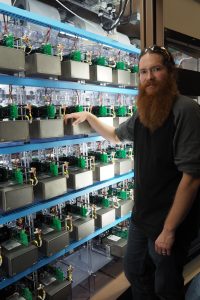
Technician Nick Gurley was one of the Fermilab team who helped install the Marx modulators for the Fermilab linear accelerator. Photo: Dan Munger
Take a walk along the hall that houses Fermilab’s linear accelerator, and you’ll see tall sets of brightly lit shelves that resemble fancy vending machines. But instead of snacks and beverages, they hold boxy structures that resemble gleaming car batteries. Arranged in neat columns and rows, these cells — known as Marx cells and installed during the last 36 months — have rejuvenated the aging Fermilab linear accelerator, or Fermilab Linac, and help guarantee its exceptional performance for the decade to come.
The installation of five new Marx modulators — each comprising 54 Marx cells — marks the conclusion of a five-year-long project to modernize critical components of the Linac. They replace equipment that had helped power accelerator components since the late 1960s.
“We needed a long-term replacement,” said Fermilab engineer Howie Pfeffer, who began designing the lab’s Marx modulator system in 2013. “We did a lot of modeling and experiments to see if the Marx structure would work. It wasn’t obvious that it would. And we determined that, yeah, we can do it. Along the way we built a number of circuits with smaller numbers of cells before committing to the full 54-cell modulators. Each circuit led us to important changes in the next.”
Most of the power that is fed to an accelerator is used to propel particles. The job of the modulator is to regulate those pulses of power — to shape them in a way that helps kick the particle beam forward at just the right time and right energies.
At Fermilab, the Marx modulators shape the pulses from a 5-million-watt amplifier, and the amplifier’s modulated power is used to accelerate protons in the Fermilab Linac. The specially formed waves propel the proton beam at a pulse rate of 15 times per second.
“The beam energy has to be exact, and most of the task of power regulation is to make sure that, as the particle beams accelerate through the Linac, they settle quickly to within one 10th of one percent of the accuracy level we want,” said Bill Pellico, leader of the Fermilab Proton Improvement Project, under which the Marx modulators were design and installed.
Capitalizing on the beam-tuning flexibility of the Marx modulators, Pfeffer and his engineering team perfectly filled the pulse prescription — a superfast, 350-microsecond pulse with a special shape specifically for injecting beam into the Linac. They also designed the modulators to make real-time corrections during the pulse, ensuring its shape would meet the accelerator’s stringent requirements. These machine learning capabilities enable the modulators to use past beam performance in improving pulse generation.
“This may be the first high-power Marx modulator with real-time pulse shaping feedback,” Pellico said.
The new modulators have improved regulation of the beam energy and also resulted in a nearly 50 percent savings in power over the older power-hungry modulators.
Marx modulators replace technology once common in analog radios and televisions — vacuum tube systems — with solid-state technology. Industry began using Marx modulators in the 1990s. Scientists, engineers and technicians have since developed a number of Marx modulators for particle accelerators, taking advantage of their efficient power use and better beam regulation.
“A lot of the old tubes in our accelerator had become obsolete. We couldn’t buy some of that stuff anymore,” Pellico said. “But now, we have not only a modern system, but also one where you can turn various cells on or off to modulate the power as desired. The design will have lots of applications in powering future particle accelerators — not just at Fermilab, but at other labs and facilities, too.”
The new, easy-to-maintain system enables the lab to generate easy-to-control particle beams, just one part of Fermilab’s effort to modernize its accelerator complex.
“Fermilab’s science program entirely depends on this working,” Pfeffer said. “It was a big responsibility. If we hadn’t gotten this work done, there’s no beam anywhere. So it feels great to see the Marx modulators completely installed and running. And thanks to our people who put it together, it’s the most beautiful circuit I’ve ever seen.”
The Proton Improvement Project is supported by the U.S. Department of Energy Office of Science.



